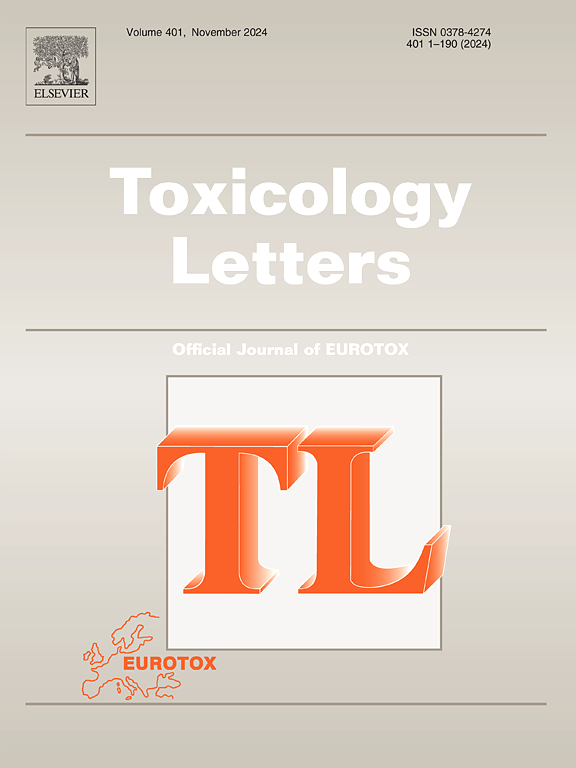植物蛋白RuBisCO的加合物与g型有机磷神经毒剂相互作用形成
IF 2.9
3区 医学
Q2 TOXICOLOGY
引用次数: 0
摘要
《禁止化学武器公约》明确禁止使用有机磷神经毒剂。有机磷神经毒剂是剧毒的胆碱酯酶抑制剂,对人类和平、健康和安全构成严重威胁。目前,对OPNAs蛋白加合物的研究主要集中在人和动物身上。然而,必须立即找到一种新颖可靠的生物标志物,以提供环境样品中OPNA暴露的回顾性鉴定。在本研究中,我们旨在拓宽各种物种神经毒剂的检测窗口,探索具有高反应性和良好稳定性的前瞻性生物标志物,并研究将植物蛋白添加到g型OPNAs中的可行性。我们研究了植物蛋白核酮糖-1,5-二磷酸羧化加氧酶(RuBisCO)。在EHHNS*PGY*Y*DGR上发现了S115/S117和Y118/Y120位点,在Y*GRPLLGCTIK*PK上发现了K175位点。还鉴定了10个可靠且稳定的肽段。tabun (GA)和soman (GD)可以同时修饰EHHNS*PGY*Y*DGR、WS*PELAAACEVWK* 、Y*GRPLLGCTIK*PK和GHYLNATAGTCEDMMK。因此,暴露于OPNAs可以回顾性验证使用这些稳定的肽。三种OPNA加合物的稳定性各不相同。沙林(GB)加合物最稳定,GA-Lys和GA-Ser老化速度最快,GD次之。如果衰老动力学在体内和特定的暴露后时间框架内得到验证,OPNA加合物的不同衰老速率可能为区分暴露源提供时间线索。本研究提出了一种新的有机磷追溯分析方法,在法医调查和化学武器核查中具有潜在的应用前景。基于计算机的高活性稳定修饰位点的分子模拟显示,氢键是形成共价化合物的驱动力。本研究有助于我们了解RuBisCO加合物修饰位点形成的机制。本文章由计算机程序翻译,如有差异,请以英文原文为准。
Adduct of the plant protein RuBisCO formed upon interaction with G-type organophosphorus nerve agents
The Chemical Weapons Prohibition Convention (CWC) explicitly prohibits the use of organophosphorus nerve agents (OPNAs), which are highly toxic cholinesterase inhibitors that pose a serious threat to human peace, health and security. Currently, protein adducts of OPNAs are mainly studied in humans and animals. However, a novel and reliable biomarker must be found immediately to provide retrospective identification of OPNA exposure in environmental samples. In this study, we aimed to broaden the detection window for nerve agents in various species, explore prospective biomarkers for their high reactivity and good stability, and examine the feasibility of adding plant proteins to G-type OPNAs. We investigated the plant protein ribulose-1,5-diphosphate carboxylated oxygenase (RuBisCO). Several modification sites were discovered, including S115/S117 and Y118/Y120 on EHHNS*PGY*Y*DGR and K175 on Y*GRPLLGCTIK*PK. Ten reliable and stable peptide segments were also identified. Both tabun (GA) and soman (GD) can concurrently modify the peptides EHHNS*PGY*Y*DGR, WS*PELAAACEVWK* , Y*GRPLLGCTIK*PK, and GHYLNATAGTCEDMMK. As a result, the exposure to OPNAs can be retrospectively verified using these stabilized peptides. The stability of the three OPNA adducts varies. The sarin (GB) adduct is the most stable, while GA-Lys and GA-Ser show the fastest aging rate, followed by GD. The differential aging rates of OPNA adducts may provide temporal clues for distinguishing exposure sources, provided that aging kinetics are validated in vivo and under specified post-exposure timeframes. This study proposes a novel method for retrospective organophosphorus analysis, with potential applications in forensic investigations and chemical weapon verification. A computer-based molecular simulation of the highly reactive stable modification sites revealed that hydrogen bonds are the driving force for the formation of covalent compounds. This study contributes to our understanding of the mechanism of modification site formation of the RuBisCO adduct.
求助全文
通过发布文献求助,成功后即可免费获取论文全文。
去求助
来源期刊

Toxicology letters
医学-毒理学
CiteScore
7.10
自引率
2.90%
发文量
897
审稿时长
33 days
期刊介绍:
An international journal for the rapid publication of novel reports on a range of aspects of toxicology, especially mechanisms of toxicity.
 求助内容:
求助内容: 应助结果提醒方式:
应助结果提醒方式:


